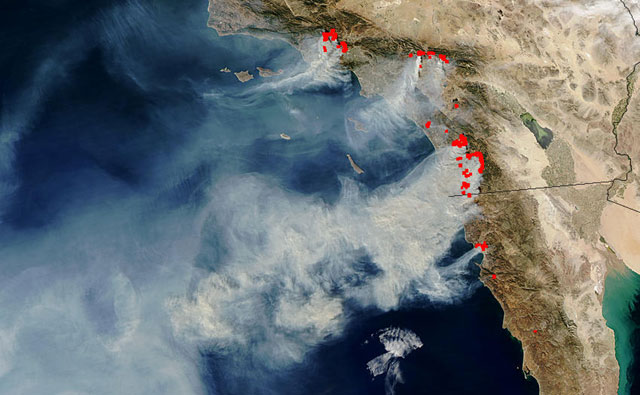- Human activities affect the Earth's climate.
- Human communities have become more vulnerable to climate based hazards.
Climate Change
Relationship between humans and the Earth's climate
During the past few decades, two important factors regarding the relationship between humans and the Earth's climate have become apparent:
Influence of human activities on climate change
- Human activities, particularly the
- burning of fossil fuels
- land-use change and
- agriculture
are increasing the atmospheric concentrations of greenhouse gases, which tend to warm the atmosphere (greenhouse effect).
- In some regions human activities substantially increase the atmospheric concentrations of aerosols (microscopic airborne particles). Those particles tend to cool the atmosphere.
Over the past 100 years there were already changes in climate, which are - at least partly - affected by human activities:
- Global mean surface temperature has increased by between about 0.3 and 0.6°C since the late 19th century, a change that is unlikely to be entirely natural in origin (view graphic).
- Global sea level has risen by between 10 and 25 cm over the past 100 years and much of the rise may be related to the increase in global mean temperature.
The changes in global mean surface air temperature and in geographical, seasonal and vertical patterns of atmospheric temperature, suggests a discernible human influence on global climate.
Stronger vulnerability of human communities to climate based hazards

Image © Nasa
Some human communities have become more vulnerable to hazards such as storms, floods and droughts as a result of increasing population density in sensitive areas such as river basins and coastal plains. Potentially serious changes have been identified, including an increase in some regions in the incidence of extreme high-temperature events, floods and droughts, with resultant consequences for fires, pest outbreaks, and ecosystem composition, structure and functioning, including primary productivity.
Climate change in the future
Given current trends of increasing emissions of most greenhouse gases, atmospheric concentrations of these
gases will increase through the next century and beyond. With the growth in atmospheric concentrations of
greenhouse gases, interference with the climate system will grow in magnitude and the likelihood of adverse
impacts from climate change that could be judged dangerous will become greater.
Future projections concerning climate evolution are based on computer simulations. The models project (relative to 1990) that:
(For more information about climate change effects see the page with the climate scientific facts.)
Future projections concerning climate evolution are based on computer simulations. The models project (relative to 1990) that:
- the mean annual global surface temperature will increase by 1 - 3.5°C by 2100 (with a "best estimate" of 2°C) (view graphic)
- the global mean sea level will rise by 15 - 95 cm by 2100 (with a "best estimate" of 50 cm) (as a result of thermal expansion of the oceans and melting of glaciers and ice-sheets)
- warmer temperatures will lead to a more vigorous hydrological cycle; this:
- translates into prospects for more severe droughts and/or floods in some places and less severe droughts and/or floods in other places
- will lead to an increase in precipitation intensity, suggesting a possibility for more extreme rainfall events
(For more information about climate change effects see the page with the climate scientific facts.)
Actions to Mitigate Climate Change
Global warming is happening. But we can do something about it. Possible actions include:
Binding targets for reductions in greenhouse gas emissions were agreed by major industrial nations meeting at the United Nations Climate Change Conference in Kyoto on December 1997. The overall targets adopted for greenhouse gas emissions by 2008-12 are an 8% cut from 1990 levels for the European Union (EU), 7% for the USA, and 6% for Japan and Canada. Australia is allowed an 8% increase, while Russia has a target of 0% (i.e. 1990 levels).
Further information:
Intergovernmental Panel on Climate Change (IPCC).
IPCC Second Assessment Climate Change 1995: A report of the Intergovernmental Panel on Climate Change.
- mitigation of climate change through reductions of emissions of greenhouse gases and enhancement of their removal by skins
- adaptation to observed and/or anticipated climate change and
- research, development and demonstration to improve our knowledge of the risks of climate change and possible responses.
Binding targets for reductions in greenhouse gas emissions were agreed by major industrial nations meeting at the United Nations Climate Change Conference in Kyoto on December 1997. The overall targets adopted for greenhouse gas emissions by 2008-12 are an 8% cut from 1990 levels for the European Union (EU), 7% for the USA, and 6% for Japan and Canada. Australia is allowed an 8% increase, while Russia has a target of 0% (i.e. 1990 levels).
Further information:
- EPA Global Warming page
- Global Warming page of the Union of concerned scientists
- Information about Global Warming by the National Oceanic and Atmospheric Administration
- NASA's Global Change Master Directory
Intergovernmental Panel on Climate Change (IPCC).
IPCC Second Assessment Climate Change 1995: A report of the Intergovernmental Panel on Climate Change.
